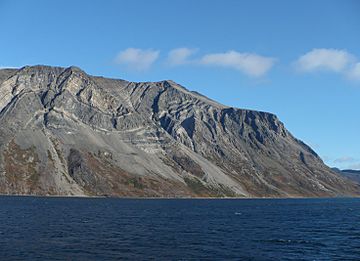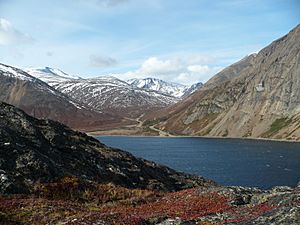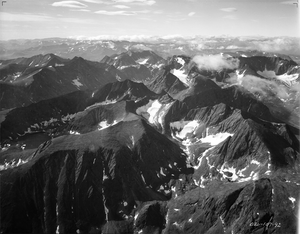Torngat Mountains facts for kids
Quick facts for kids Torngat Mountains |
|
|---|---|

Folded rocks of the Torngat Mountains
|
|
| Highest point | |
| Peak | Mount Caubvick (Mont D'Iberville) |
| Elevation | 1,652 m (5,420 ft) |
| Dimensions | |
| Area | 30,067 km2 (11,609 sq mi) |
| Geography | |
| Country | Canada |
| Range coordinates | 59°25′N 64°30′W / 59.417°N 64.500°W |
| Parent range | Arctic Cordillera |
The Torngat Mountains are a large mountain range in Canada. They are found on the northern part of the Labrador Peninsula. This area is where Newfoundland and Labrador meets eastern Quebec. These mountains are part of the Arctic Cordillera, a long chain of mountains. The Torngat Mountains form a land area that separates Ungava Bay from the Atlantic Ocean.
Contents
What Does "Torngat" Mean?
The name Torngat comes from the Inuktitut language. It means place of spirits. Some people also say it means place of evil spirits.
Where Are the Torngat Mountains?
The Torngat Mountains cover a very large area. About 56% of the mountains are in Quebec. Another 44% are in Labrador. A very small part, less than 1%, is on Killiniq Island in Nunavut.
The Torngat Mountains cover about 30,067 square kilometers (11,609 sq mi). They stretch for over 300 kilometers (186 mi). This is from Cape Chidley in the north to Hebron Fjord in the south. These mountains have the highest peaks in eastern continental Canada.
Highest Peaks
The tallest point is Mount Caubvick. It is also called Mont D'Iberville. This peak is 1,652 meters (5,420 ft) high. There are no trees in the Torngat Mountains. This is because the climate is like an arctic tundra. This means it is too cold for trees to grow.
The ground here has Permafrost. This is ground that stays frozen all year. It is always frozen on the Quebec side. On the Atlantic side, it is mostly frozen but not everywhere. The land is very rocky and often looks like a desert. It is usually more than 300 meters (984 ft) above sea level.
| Rank | Name | Height (meters) | Height (feet) |
|---|---|---|---|
| 1 | Mount Caubvick | 1652 | 5420 |
| 2 | Torngarsoak Mountain | 1595 | 5232 |
| 3 | Cirque Mountain | 1568 | 5144 |
| 4 | Peak 5100 (24I/16) | 1554+ | 5100+ |
| 5 | Peak 5074 | 1547 | 5074 |
| 6 | Mount Erhart | 1539 | 5049 |
| 7 | Jens Haven | 1531 | 5023 |
| 8 | Peak 5000 (24P/01) | 1524+ | 5000+ |
| 9 | Peak 5000 (24I/16) | 1524+ | 5000+ |
| 10 | Innuit Mountain | 1509 | 4951 |
How the Mountains Were Formed (Geology)
The rocks that make up the Torngat Mountains are called gneisses. These rocks are very, very old. They are some of the oldest rocks on Earth. Scientists believe they are about 3.6 to 3.9 billion years old. These ancient rocks are part of the Canadian Shield. This is a huge, old part of the Earth's crust.
The mountains themselves were formed more recently. This happened through a process called orogeny, which means mountain-building. This process involved the folding and breaking of the Earth's crust. This is how the Arctic Cordillera mountains were created. You can see how the rocks folded and broke apart. This is especially clear at Saglek Fjord.
Ice and Glaciers
The different parts of the Torngat Mountains are separated by deep fjords. Fjords are long, narrow inlets of the sea with steep sides. They were carved out by glaciers. The Laurentide Ice Sheet, a huge ice sheet, once covered most of these mountains. However, during the last ice age, less of the mountains were covered.
Today, there are over 100 small, active mountain glaciers in the Torngat Mountains. In total, there are about 195 ice masses in the area.
Wildlife and Plants (Ecology)
| Torngat Mountain tundra | |
|---|---|

Torngat Mountains and Nachvak Fjord
|
|

Location of the Torngat Mountain tundra ecoregion in North America
|
|
| Ecology | |
| Realm | Nearctic |
| Biome | Tundra |
| Borders | Eastern Canadian Shield taiga and Middle Arctic tundra |
| Geography | |
| Area | 32,375 km2 (12,500 sq mi) |
| Country | Canada |
| Provinces | Newfoundland and Labrador and Quebec |
| Conservation | |
| Conservation status | Relatively Stable/Intact |
Plants of the Torngats (Flora)
The Torngat Mountain tundra has very few plants. You will mostly find thin patches of arctic sedge, grass, lichen, and moss. In some sheltered spots, especially on sunny slopes, you might see small arctic shrubs. These shrubs become more common as you go further south.
Animals of the Torngats (Fauna)
The tundra here is a home for many animals during different seasons. You can find caribou and polar bears. It is also home to the only black bears in the world that live in the tundra. The coastal areas are important for birds that migrate along the Atlantic flyway.
Protecting the Torngat Mountains
The Torngat Mountains National Park Reserve was created on December 1, 2005. The park's goal is to protect the amazing wildlife. This includes animals like caribou, polar bears, peregrine falcon, and golden eagle. The park also offers fun outdoor activities for visitors.
See also
 In Spanish: Montes Torngat para niños
In Spanish: Montes Torngat para niños


